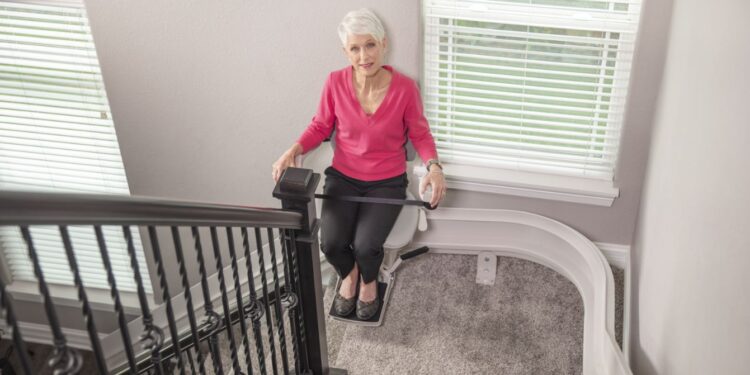Stair lifts are a practical and efficient home accessibility solution that provides individuals with mobility challenges with a convenient way to move between floors. If you’re somewhat familiar with this mobility aid and their benefits but haven’t had the chance to experience one firsthand, you might have encountered some common myths about it.
Considering the purchase of a stair lift can seem daunting because of the sheer amount of information and misconceptions floating around. This article differentiates between myth and fact, shedding light on the truths surrounding stair lifts.
Table of Contents
Myth 1: It Occupies the Entire Staircase
Even after the installation, there will be sufficient space for others to walk up and down the stairs. The arms, seat, and footrest of the stair lift chair can be folded up at both the top and bottom landing of the staircase. This feature allows for clear passage for anyone using the stairs on foot. In most homes, staircases are spacious enough to accommodate the fitting of a stair lift.
Myth 2: It Is Not Suitable for Curved Stairways
While installations of stair lifts on straight staircases might be more prevalent in some areas, numerous models are designed for stairways that feature curves, turns, or intermediate landings. These specialized home accessibility solutions are referred to as curved stair lifts.
To ensure a perfect fit for a curved rail, your installer will visit your home to take detailed photographs and measurements of your stairs. These are then forwarded to the manufacturer, who will custom-design and construct the rail.
Myth 3: It Runs Entirely on Electricity
While a conventional electrical outlet at either the top or bottom of the staircase is necessary for connection, stair lifts are actually powered by batteries. The charging contacts ensure that, even in the event of a local power failure, the mobility device can still be used several times to move between floors in your home.
Myth 4: It Is Attached to the Wall
When installing a stair lift, the rail is not mounted to the wall but instead secured to the stair treads themselves. This means that your walls remain untouched and unharmed.
Should the stair lift be removed, those with carpeted stairs might find the screw holes left behind are hardly noticeable. The carpet’s fibers typically hide these small indentations well.
For those with wooden stairs, the remaining holes are minimal and easily dealt with. A simple solution is to fill them with wood-colored putty available at any hardware store. For a more DIY approach, a golf tee can be tapped into the hole. A bit of sanding and a touch-up with either paint or stain can make these holes virtually disappear.
Myth 5: It Moves Slowly
The rate at which a stair lift ascends or descends can differ across various brands and models, typically ranging between 15 and 25 feet per minute. Given that the typical home staircase measures around 14 feet in length, it generally takes less than a minute to travel from one end to the other. While some might find this lengthy, it’s helpful to compare it to the duration it would take to walk on the stairs safely.
In many instances, opting for a stair lift can save time. Even if it means spending a few extra seconds on the stairway, the added safety and peace of mind that come with using this mobility equipment are invaluable benefits.
Myth 6: It Is Only for Seniors
Indeed, stair lifts are commonly associated with elderly individuals who have limited mobility, but they’re not exclusively for seniors. This equipment can be incredibly beneficial for people of any age who have experienced a significant injury or face a mobility challenge that makes using stairs unsafe.
Take, for instance, someone who has suffered from an accident or sports injury affecting their knee or foot. They might need help to use stairs for several weeks or months. In such cases, renting a stair lift could provide a practical solution, offering the necessary assistance for moving between floors at home during their recovery period.
Myth 7: It Makes You Lose Your Independence
Many people worry that installing a stair lift might mean giving up their autonomy if they are unable to use stairs on foot. But, introducing this mobility aid into your home can actually reclaim your independence, offering a safer and more manageable method of moving between your house’s floors.
Ready To Make Your Home More Accessible?
Contact a trusted mobility equipment supplier today and discover the range of home accessibility solutions available to you. With their expert advice and state-of-the-art products, you can find the perfect stair lift that meets your specific needs. Make the first step towards enhanced mobility and independence to ensure you or your loved ones can enjoy every level of your house with ease and confidence.


 Home
Home










